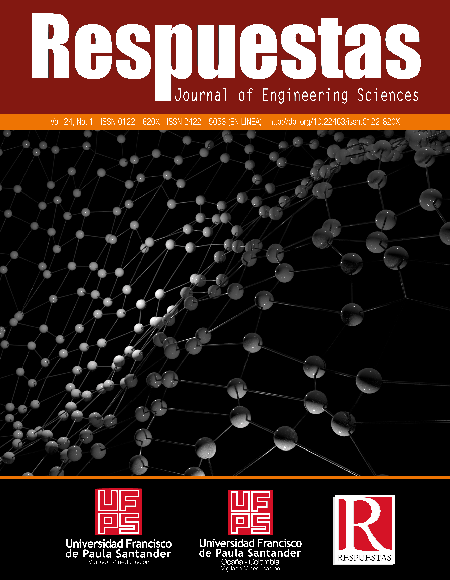Behavior of an asphalt mixture MDC-19 under the cycles of ambient temperature in the city of Tunja, Colombia
Comportamiento de una mezcla asfáltica MDC-19 bajo los ciclos de temperatura ambiente en la ciudad de Tunja, Colombia
Main Article Content
The weather factor plays an important role in the behavior and performance of asphalt mixtures as a surface layer in a flexible pavement structure, not just from the moisture, but also from the environmental temperature. Asphalt layers of the flexible pavements in Tunja city exposes daily to environmental temperature variations, which usually occur when the highest temperatures are reached during the daytime, and the lowest temperatures appear at night and early morning time. Firstly, this research is based , on the definition of the environmental temperature cycles that occur daily in Tunja City, from the analysis of the temperature series. Subsequently, the analysis was done through laboratory tests on an asphalt mix MDC-19 INVIAS type, made and compacted in the laboratory, to determine the influence of the cycles of environmental temperature on its density, stability and flow properties, during 120 daily and continuous temperature cycles, which consist of 12 hours of maximum temperature and 12 hours of minimum temperature to simulate the environmental conditions. As a result of this investigation, the presentation density is presented, presenting a tendency to increase the measurement that increases the temperature cycles and then a decrease in the briquettes of the mixture that have sometimes been until the last cycles. Variations in the resistance to deformation of the analysis mixture were obtained as the ambient temperature cycles were sometimes made, which concludes that the ambient temperature cycles have an influence on the behavior of the asphalt mixture.
Downloads
Article Details
G. Valdés, F. Pérez-Jiménez & A. Martínez. “Influencia de la temperatura y tipo de mezcla asfáltica en el comportamiento a fatiga de los pavimentos flexibles”, Revista de la Construcción, vol. 11, pp. 87-100, abril 2012. doi: https://dx.doi.org/10.4067/S0718-915X2012000100009.
O. Reyes, J. Camacho, y F. Reyes. “Influencia de la temperatura y nivel de energía de compactación en las propiedades dinámicas de una mezcla asfáltica”, Revista Facultad de Ingeniería Universidad de Antioquia. pp. 126, marzo 2006 doi: http://www.redalyc.org/articulo.oa?id=43003611
IDEAM Instituto de Hidrología, Meteorología y Estudios Ambientales de Colombia, Subdirección de Meteorología. Cartas climatológicas de las principales ciudades, UPTC. Diciembre 2016. [Online]. Disponible en: http://www.ideam.gov.co/documents/21021/21789/1Sitios+turisticos2.pdf/cd4106e9-d608-4c29-91cc-16bee9151ddd.
IDEAM Instituto de Hidrología, Meteorología y Estudios Ambientales de Colombia, Subdirección de Meteorología. Informes digitales de registros de variables climáticas de la ciudad de Tunja. Serie Años 2000 a 2016, Estación IDEAM UPTC. Tunja,Colombia. 2017.
K. Nesnas, M. Nunn. “A Model for top-down Reflection Cracking in Composite Pavements”, Fifth International RILEM Conference on ReflectiveCracking in Pavements, (Limoges, France), pp. 409-416, Rilem Proceedings Pro, abril 2004.
N. Huamán Guerrero, C. M. Chang Albitres. “La deformación permanente en las mezclas asfálticas y el consecuente deterioro de los pavimentos asfálticos en el Perú”, Perfiles de ingeniería, vol. 2, no 11, pp. 23-31, noviembre 2016. ISSN 2519-5719. [Online]Disponible en: http://revistas.urp.edu.pe/index.php/Perfiles_Ingenieria/article/view/402
W. Si et al. “Impact of Freeze-Thaw Cycles on Compressive Characteristics of Asphalt Mixture in Cold Regions”, Journal of Wuhan University of Technology-Mater. Sci. Ed. 30. 703-709, julio 2015. doi: 10.1007/s11595-015-1215-5.
M. Kestler, R. Berg & S. Bigl. “Statistical Significance of Freeze-Thaw Related Factors on Cumulative Damage to Flexible Pavements”, Transportation Research Record Journal of the Transportation Research Board, vol. 2232, pp. 2232(-1):55-67, enero 2011. doi: https://doi.org/10.3141/2232-06.
Instituto Nacional de Vías. Manual de normas de ensayo de materiales para carreteras. Bogotá D.C., Colombia. INVIAS, 2013.
Instituto Nacional de Vías. Especificaciones generales de construcción de carreteras. Bogotá D.C. Colombia. INVIAS, 2013.
C. H. Higuera. Nociones sobre métodos de diseño de estructuras de pavimentos para carreteras. Volumen I y II. Tunja, Colombia: Universidad Pedagógica y Tecnológica de Colombia, pp. 8-43, 2011.
Shell International Petroleum Company Limited. Shell pavement design manual – Asphalt pavements and overlays for road traffic. Londres, Inglaterra. 1978.
P. Pan, S. Wu, X. Hu, G. Liu & B. Li. “Effect of Material Composition and Environmental Conditionon Thermal Characteristics of Conductive Asphalt Concrete”, Materials, vol. 10, pp. 1-17, febrero 2017. doi:10.3390/ma10030218.
E. Özgan, S. Serin. “Investigation of certain engineering characteristics of asphalt concrete exposed to freeze–thaw cycles”. Cold Region Science and Technology, vol. 85, pp. 131- 136, enero 2013. doi: https://doi.org/10.1016/j. coldregions.2012.09.003.
H. Rondón, F. Reyes. “Influence of the Bogotá environmental conditions on the mechanical behavior of an asphalt mixture”, Revista ingeniería de construcción, vol. 24, pp. 195-207, agosto 2009. doi: http://dx.doi.org/10.4067/S0718-50732009000200006.
H. Rondón, F. Reyes. “Evaluation of mechanical parameters of an asphalt mixture under the environmental conditions of Bogotá D.C.”, Revista Ingeniería de construcción, vol. 27, pp. 57- 74, abril 2012. doi: http://dx.doi.org/10.4067/S0718-







